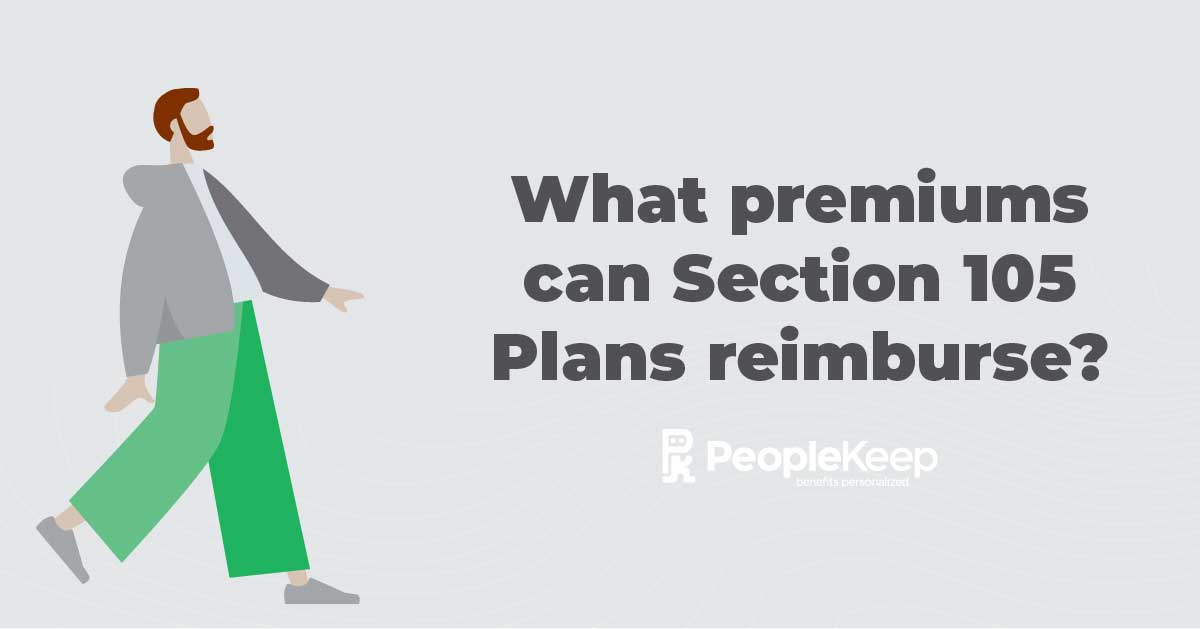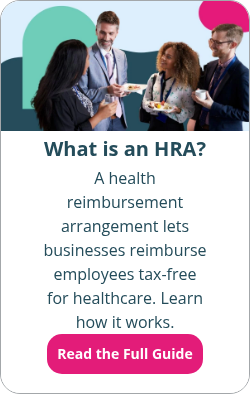Section 105 plan vs. Section 125 cafeteria plan
By Elizabeth Walker on December 20, 2023 at 9:35 AM
Due to rising health costs, many small business owners are looking for new ways to provide affordable and comprehensive health benefits. To maximize cost savings, more employers are offering tax-advantaged health benefits, like Section 105 and Section 125 plans instead of traditional options like group health insurance.
These two types of plans come with tax benefits and flexibility and can also attract and retain key employees. But while they have some similarities, they also have many essential differences that can impact your decision on which to offer at your organization.
This article will compare Section 105 and Section 125 plans so you can make the right choice for you and your employees.
What is a Section 105 plan?
A Section 105 plan allows employers to reimburse employees for various medical expenses tax-free. Employers commonly set up Section 105 plans as self-funded benefits, where employers take on the responsibility of handling and funding claims rather than relying on a third party, like an insurance company, to do that for them.
The following chart describes some common Section 105 plans:
|
Plan type |
How it works |
|
As one of the most common types of Section 105 plans, HRAs allow employers to reimburse employees for out-of-pocket medical expenses and sometimes individual health insurance premiums. The three HRAs PeopleKeep offers are the qualified small employer HRA (QSEHRA), the individual coverage HRA (ICHRA), and the group coverage HRA (GCHRA). |
|
|
Excepted benefit HRA (EBHRA) |
Another type of HRA, the EBHRA, reimburses employees for excepted benefits that traditional health insurance plans don’t include, like dental care and vision coverage. |
|
A MERP reimburses employees and their dependents for out-of-pocket medical expenses. Employers can offer this plan on its own or alongside group health insurance. An HRA is a type of MERP. |
|
|
Accident and health plans |
This employer-sponsored supplemental health coverage protects employees from potential workplace accidents that may affect their health or well-being. |
How does a Section 105 plan work?
To compliantly set up a Section 105 plan, employers must establish formal plan documents outlining the benefit details, including eligible expenses for reimbursement, plan period dates, the monthly or annual allowance they’re offering employees, plan design, and more.
When choosing your allowance, it’s important to remember that some Section 105 health plans, like QSEHRAs, have maximum annual employer contribution limits, while ICHRAs and integrated HRAs (also known as GCHRAs) don’t have any contribution limits. In either case, contributions are tax-deductible as a business expense to the employer.
Once you finish setting up your benefit, the way a Section 105 plan works is simple. When an employee submits proof that they purchased an eligible expense, the employer reviews the documentation. If the employer approves the expense, they reimburse the employee tax-free up to the set allowance amount.
Employers of all sizes can offer a Section 105 medical plan, and current W-2 employees, including their spouses and dependents, can participate. With some Section 105 plans, like the ICHRA, employers can offer the benefit with customized allowance amounts to different employee classes, such as full-time employees, part-time, seasonal, and temporary employees.
However, business owner eligibility depends on their tax filing status and the type of organization they run. Essentially, qualified business owners can only participate in the benefit plan if the IRS considers them an employee.
Employers can self-administer a Section 105 plan. However, they have special rules employers must follow. Therefore, using a third-party administrator (TPA) or benefits administration software makes managing the plan easier with less risk of compliance issues. Otherwise, employers must understand and follow ERISA, Affordable Care Act, HIPAA, or nondiscrimination testing regulations on their own.
Want more detailed information about Section 105 plans? Check out our complete guide
What is a Section 125 plan?
A Section 125 plan, also known as a cafeteria plan, allows employees to take a taxable portion of their entire compensation and receive it as a qualified benefit on a pre-tax basis. IRS-approved qualified benefits1 under Section 125 plans include healthcare premiums, accident and disability insurance, retirement contributions, adoption assistance plans, and health savings accounts (HSAs).
Employers can offer Section 125 plans independently or in addition to an employer-sponsored health plan.
Because cafeteria plan contributions use pre-tax deductions, an employee’s taxable income decreases, which can lower their tax liability when it’s time to file their annual tax return. It also means they will pay less Medicare and Social Security taxes. Additionally, the employer’s tax liability lessens, and they can save an extra 7.65% in payroll taxes.
The following chart describes some common Section 125 plans:
|
Plan type |
How it works |
|
Full-flex cafeteria plan |
Employers offering this plan make non-elective contributions that eligible employees can use to purchase qualified benefits. Current employees may also make contributions under this plan. |
|
Simple cafeteria plan |
Simple cafeteria plans are only for employers with fewer than 100 employees and must meet specific guidelines regarding contribution, eligibility, and participation rules. |
|
Premium-only plan (POP) |
A POP allows employees to pay their health insurance premiums with pre-tax dollars. Premiums are the only eligible expenses under this plan. But they can be group or individual health insurance premiums. |
|
An FSA is a savings account allowing employers and employees to make contributions on a pre-tax basis to pay for various expenses. The most popular type of FSA is a healthcare FSA, which allows employees to pay for healthcare costs. Unlike HSAs, employees lose their FSA funds if they don’t spend them by the plan year's end. |
How does a Section 125 plan work?
Similar to a Section 105 plan, Section 125 plans require formal plan documents before employers can offer the benefit. Most organizations consult with an attorney, tax professional, broker, or TPA to establish these documents.
Next, you must notify your current employees of the benefit and have a process in place to manage the benefit, such as using a TPA or benefits administration software.
Lastly, you must run any Section 125 benefits through three nondiscrimination tests annually and keep the results on file.
Employers of all sizes can offer a Section 125 plan, and they’re available to U.S. employees subject to income taxes, their spouses, and their dependents. You can also include former employees in the benefit, but they can’t be the primary participants.
Additionally, certain individuals can’t participate in Cafeteria plans due to compliance regulations, including self-employed business owners and shareholders who own more than 2% of a subchapter S-corporation.
Are you interested in learning more about Section 125 plans? Check out our blog.
Conclusion
Section 105 and 125 plans both allow employers to make contributions using pre-tax dollars toward their employees’ medical care costs. However, critical differences exist in each plan’s design, contribution structure, and qualified expenses. So it’s essential to consider the pros and cons carefully before choosing which type of plan to offer at your organization.
Having flexible medical benefits remains a top priority for employees today. By offering an HRA through PeopleKeep, we’ll provide you with a customizable health benefit that can meet all your employees’ diverse needs. Better yet, our HRA administration software simplifies time-consuming tasks while keeping you compliant so you can focus on your business.
This article was originally published on July 15, 2015. It was last updated on December 20, 2023.
Check out more resources
See these related articles

FAQ: Can owners participate in Section 105 medical reimbursement plans?
Can an owner participate in a Section 105 Plan? This FAQ answers whether an owner can participate in a Section 105 Medical Reimbursement Plan.

What health insurance premiums can Section 105 plans reimburse?
Discusses the types of health insurance premiums Section 105 plans can reimburse.

Section 105 Medical Reimbursement Plans: FAQs
Three FAQs on Section 105 Medical Reimbursement Plans. The top three questions about Section 105 plans from small business owners.



